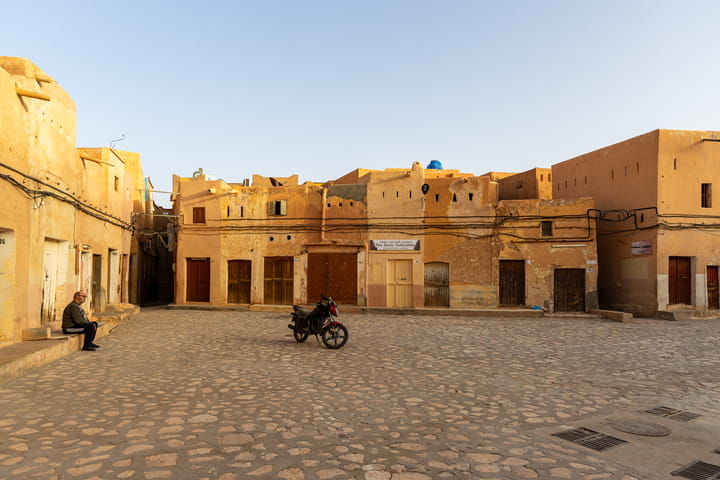Beni Isguen
Beni Isguen, Algeria
The market square of Beni Isguen was surrounded by low, narrow buildings, each one with a double door that took up most of the façade. There were no windows on the ground floor, and the ones on the floor above were often little more than slits. It gave the whole, mostly empty square a closed-in and deserted feeling.
The square itself was not entirely empty. In the center were small piles of miscellaneous objects – a new-looking cooktop, a rather ancient chest expander, and assorted pieces of crockery. A metal tray with a teapot and a few small glasses sat on the ground next to them. Around these random artifacts were a small group of men in brown and cream robes, studying each item as it was picked up and presented by one of the two men acting as auctioneers that day.
Public auctions in Beni Isguen take place in the late afternoon, and the auctioneers are men selected for their honesty and reliability by the council of the mosque. Anyone who has something to sell can bring it to the auctioneer, agree on a reserve price and the auctioneer's fee, and then wait for the auctioneer to sell it for them. The auctions are silent, and in keeping with the Mozabite values, they are arranged to discourage competitive bidding or flashy displays of wealth. Buyers remain in the auction by default until they discreetly signal the auctioneer to let him know that they are no longer interested. The last man standing takes home the item. Watching the proceedings, I had a sense that some of those there might be buying things not because they wanted them, but to relieve the hardship of whichever of their neighbors had been reduced to selling his cooktop or his chest expander to make ends meet.
Beni Isguen is not the oldest of the five towns of the pentapolis, but it is sacred, and access by outsiders is strictly controlled. Non-Mozabites are forbidden to spend the night within the walls of the ksour. Tourists must be accompanied at all times by a guide, and parts of the town are strictly off-limits. Photography of people is firmly discouraged.
In addition to describing the finer details of the auctions, my guide explained the buildings around the edge of the market square with their narrow façades and double doors. They were not, as I had first assumed, shops. Instead, each one was owned by a different family of the town. On market days, the doors would be thrown open and important memebers of the family would seat themselves in the little room inside. From there, they could watch the activity of the market, and receive visits from neighbors or members of their own clan. In a sense, they were an equivalent of the Arab majlis or receiving room, but transplanted from the family home – by Mozabite tradition, a place kept somewhat apart and accessible only to a select few – into the public square.
From the market square, we climbed up toward the top of the ksour. My guide pointed out public wells, each one with its accompanying palm tree to mark the location of the well and act as a kind of living gauge of the amount of water available. From time to time, two-man teams of construction workers passed us on their way to patch up one or other of the houses. The workers in Beni Isguen seemed to be mostly sub-Saharan Africans, and each team of two had a donkey to help carry the sand up the steep streets of the ksour. Sand up, and men down; when it was time to go back down to pick up another load of sand, one of the men would ride the now unladen donkey. It seemed like a practical and even equitable arrangement, although the uncomplaining donkeys might have had thoughts of their own on the subject.
